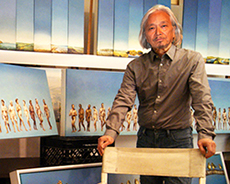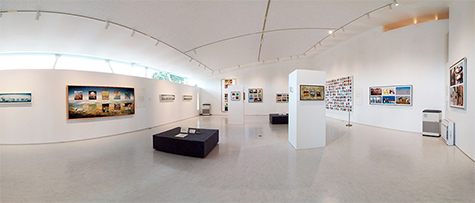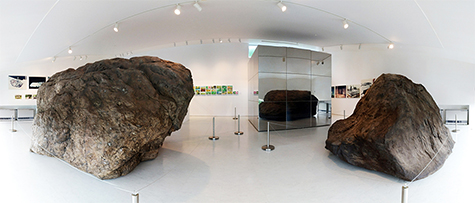Rikuro Okamoto started drawing at the age of 4 or 5, and has been living in the world of artistic creation 24 hours a day, 7 days a week, up to the present. Upon entering elementary school, he began drawing every week under the guidance of the painter Kogyoku Matsunaga, acquiring the foundations over many years. During his childhood, he took a meandering path, exploring the realms of literature, poetry, physics, mathematics, engineering, film, and rakugo, dedicating ample time to these pursuits. He chose to live in the world of artistic creation and left Japan at the age of 26.
In 1969, he moved to New York to focus on his career as an artist and has been engaged in creative activities for over 50 years. In New York, he constantly explores and ventures into new realms of creation, breaking through conventional wisdom, logic, and rules, while honestly facing the purity of nature, aiming for a freshness that transcends time.
Over the years, he has held solo and group exhibitions in galleries and institutions such as the Museum of Modern Art (MoMA) in New York, as well as installing his works in cities like Chicago and Rochester. However, more important than his worldly career is the completeness and depth of contemplation found in his artworks.
Many of his paintings and drawings as well as "Moving Rock" sculptures take several years to several decades to complete. He devotes as much time as necessary to achieve the completion of his works, sparing no effort. The gigantic and almost “absurdly absurd irrational world of innocence” in "Moving Rock" is born from the concentration and immersion in his efforts.
While living in the artificial city of New York, he has not been satisfied with the confined human realm of urban life. He has traveled to the places around magnificient nature such as Africa, the Amazon, Turkey, Greece, Mongolia, and Costa Rica. And in his daily life, he has developed close relationships with the plant world, the sparrow world, and the squirrel world in New York's Central Park and Madison Square Park. The result of his unwavering confrontation with reality while living alongside these pure beings is reflected in his works. His body of work portrays a strong world where all beings living in nature are equal.
After wandering through the vast nature of the world, he returned to Japan and opened Rikuro Okamoto Museum on June 10, 2006, where the Aso Buddha taking a nap, the vast sky of Kuju mountains, and the wind swept green meadows warmly welcomed his artworks.

Hours
Admission
Address
Phone
contact
Direction
Every day except Thursdays, 10:00 am - 4:30 pm
(Closed from December 1 through March 31)
Adults ; 500 yen
High school student ; 300 yen
Primary school student ; free
628-15 Yutsubo, Kokonoe-Machi, Kusu-Gun, Oita, 879-4912 Japan
+81-0967-48-8550
rikurookamoto39@gmail.com
Kumamoto Airport is the nearest airport.
Take Yamanami Highway approximately
1 hour 20 minutes to Senomoto.
Or, from Fukuoka Airport, it takes a little more than 2 hours.
Taxis, buses and rental cars are available at the airport.
View Rikuro Okamoto Museum in a larger map
Artwork: “Observation White Deck : Rocinante” was finished in 2019.
It was meticulously designed and produced by Rikuro Okamoto and took one year to complete.
“Rocinante”is named after the poor, aged and beloved horse of Don Quixote.
Anybody can walk up the steps of “Rocinante” and can see the vast, infinite view of the world.
Rikuro Okamoto Museum Foundatin
Directors : Kenji Murata, Tomoko Kawazu, Ben Kajiwara, Kazunori Yamaguchi, Motoe Watanabe, Rikuro Okamoto
Trustees : Shinkyou Kushiyama, Mutsuko Miyazaki, Eriko Teshima, Matsuko Saito, Suzuko Shiota , Keiko Okamoto
Auditors : Fimio Nishimura, Hiromi Kuwahara
Association Directors: Etsuo Kawazu, Nobuhisa Yasui, Norikazu Ui, Kazuko Yamamoto, Takashi Yamamoto, Seiji Anan, Kaitaro Masumori, Noriko Kuratani, Atsushi Hattori, Shizuka Hattori, Tamie Miyashita, Yumie Nakamura, Chie Kawaguchi
Honorary Officers : Kikuyo Shiga, Eiko Murata, Michiko Hattori, Yasuo Hattori





